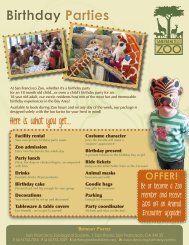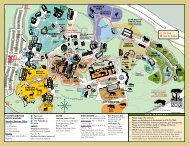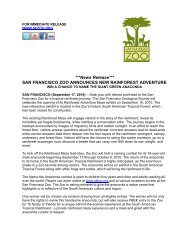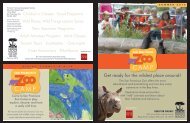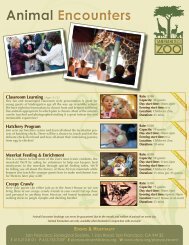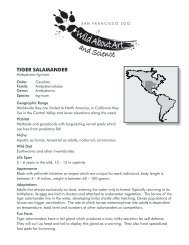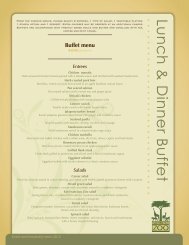Zoo Views - San Francisco Zoo
Zoo Views - San Francisco Zoo
Zoo Views - San Francisco Zoo
Create successful ePaper yourself
Turn your PDF publications into a flip-book with our unique Google optimized e-Paper software.
“Carey Baldwin would take [me] and a couple of my friends all over the zoo. They would let us go places<br />
and do things that would most likely be frowned upon these days because of safety concerns [such as]<br />
washing the elephants with large brooms. My most memorable experience was feeding newborn snow<br />
leopard cubs in Baldwin’s kitchen. My first attempt at feeding the hippo, I believe it may have been Puddles,<br />
was almost a disaster. We were using a large shovel with a short handle and I didn’t quite get the shovel out of<br />
the way of the descending upper jaw. The shovel got flipped out of my hands into the air…fortunately…without<br />
hitting anyone. We used to run little motorized boats up and down the creek over near where the polar bears are now.”<br />
— Phil Van Tassell<br />
VISITOR<br />
M<br />
E M O R Y<br />
organization in 1954, initially for the purpose of assisting<br />
in the enhancement, beautification and improvement of<br />
the <strong>Zoo</strong>’s grounds, but later to expand man’s knowledge<br />
and appreciation of the animal world, thereby furthering<br />
the preservation of the world’s wildlife heritage.<br />
During the 1960s, the challenge facing zoos everywhere<br />
changed markedly. The phrase, “endangered species”<br />
became commonplace, reflecting the threat to wildlife<br />
worldwide. Education became an important role for<br />
zoos – providing information and developing the public’s<br />
awareness of the importance of conservation. An industry<br />
whose goal for 5,000 years was to show off exotic animals<br />
for entertainment began to take on a greater purpose –<br />
conservation, education and scientific research. Breeding,<br />
health, safety, enrichment, and nutrition standards needed<br />
to be regulated and physical contact between the animals<br />
and visitors minimized.<br />
Older photos showing laxer safety standards that illustrate less-enlightened attitudes<br />
towards conservation and animal care. Today, the <strong>San</strong> <strong>Francisco</strong> <strong>Zoo</strong> is dedicated<br />
to creating exhibits that evoke natural behaviors and providing educational<br />
opportunities for guests.<br />
In 1968, <strong>Zoo</strong> Director Ronald Reuther established one of<br />
the country’s first docent programs. Excitement grew in the<br />
1980s – federal and private funding allowed the <strong>Zoo</strong> to<br />
open more naturalistic exhibits with informative graphics<br />
and interpretive displays including Wolf Woods, Musk<br />
Ox Meadow, Gorilla World (now Jones Family Gorilla<br />
Preserve), Penguin Island, Koala Crossing, the Thelma<br />
and Henry Doelger Primate Discovery Center, and Phoebe<br />
Hearst Discovery Hall. In 1984, the <strong>Zoo</strong> had a recordbreaking<br />
temporary exhibition of the Giant pandas from<br />
the People’s Republic of China.<br />
In 1993, the <strong>Zoo</strong>logical Society took over management<br />
and operations of the <strong>Zoo</strong> from the City in a unique<br />
Lease Partnership Agreement. Since that time, the Society<br />
has made vast improvements and additions throughout<br />
the <strong>Zoo</strong>, including Otter River, the Feline Conservation<br />
Center, Australian WalkAbout, Flamingo Lake, the Wart<br />
Hog exhibit, the Aviary, the Avian Conservation Center and<br />
much more. With voter-approved funding from a 1997<br />
bond measure and private donations, the <strong>Zoo</strong> rebuilt its<br />
entire western portion, restoring the Dentzel Carousel and<br />
opening the Connie and Bob Lurie Education Center, Koret<br />
Animal Resource Center, Children’s <strong>Zoo</strong>, Family Farm,<br />
the Friend and Taube Family Entry Village, <strong>Zoo</strong> Street, the<br />
Lipman Family Lemur Forest, Leaping Lemur Café, the<br />
African Savanna, and Hearst Grizzly Gulch.<br />
Today, what began with a man and a bear has become<br />
a thriving zoo boasting almost 250 species. Through its<br />
conservation work in Madagascar, its bald eagle breeding<br />
and release program in the <strong>San</strong>ta Catalina Islands, and its<br />
participation in endangered species breeding programs,<br />
the <strong>Zoo</strong> has made a difference in preserving wild places<br />
and wild things for future generations.<br />
To learn more: “A History of the<br />
<strong>San</strong> <strong>Francisco</strong> <strong>Zoo</strong>” – available at<br />
the Wildlife Connection Gift Shop.<br />
NEW! “Images of America: <strong>San</strong><br />
<strong>Francisco</strong> <strong>Zoo</strong>.” Available in stores<br />
and online soon.<br />
1940 Fleishhacker <strong>Zoo</strong><br />
opening day.<br />
1954 The <strong>San</strong> <strong>Francisco</strong><br />
<strong>Zoo</strong>logical Society is<br />
established as a nonprofit<br />
membership organization.<br />
1964 <strong>Zoo</strong>logical Society takes over<br />
operations of Storyland from the<br />
City and initiates what is now the<br />
Children’s <strong>Zoo</strong>.<br />
1975 Animal Hospital opens and<br />
includes an operating room, treatment<br />
room; laboratory, x-ray, quarantine and<br />
long-term animal care facilities.<br />
1993 The <strong>Zoo</strong>logical Society<br />
enters into a Lease and<br />
Management Agreement<br />
with the City and County of<br />
<strong>San</strong> <strong>Francisco</strong>.<br />
www.sfzoo.org 7



